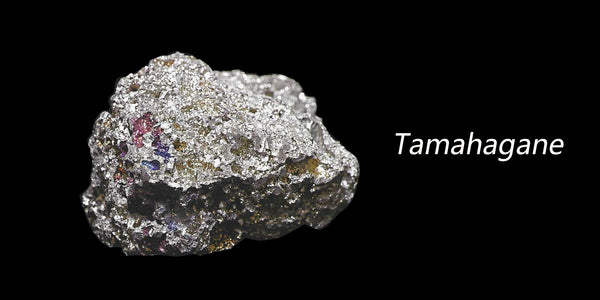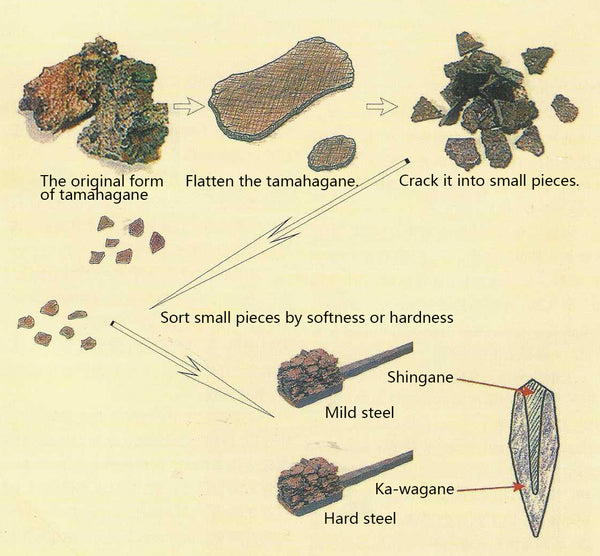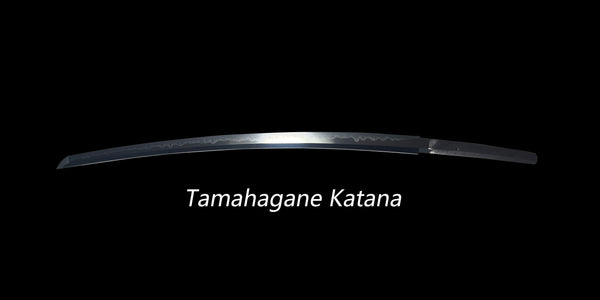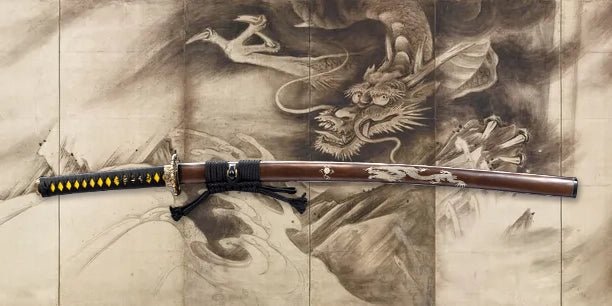Is tamahagane the strongest Japanese steel ?
What is tamahagane steel made of ?
The raw materials for tamahagane are iron ore (satetsu) in the form of sand and charcoal. Satetsu was extracted from the sand in the riverbed in the Edo period.
Satetsu is extracted from the sand in the riverbed, and in the Edo period, the sand was washed through a waterway with wooden bars, and the iron sand was separated by leaving the heavier iron sand in place and the lighter sand washed away by the water.
Charcoal, on the other hand, is not only a fuel, but it is also an oxide of iron that is refined from iron sand and reacts with carbon to claim iron and carbon dioxide. Charcoal is also a source of carbon
steel, which is a source of essential carbon. Therefore, the charcoal used for smelting tamahagane is very delicate, and pine charcoal is generally used.
Once the charcoal is extracted from the satetsu, a traditional smelting furnace called a tatara is used to create tamahagane.

What is special about tamahagane ?
Sand iron melted with tatara has a high carbon content in the steel, up to two to one percent. However, to build a functional katana, the ideal
The ideal carbon content of the steel is 0.6 to 0.7. Therefore, after obtaining tamahagane from tatara, the swordsmith's first task is to refine the steel so that the carbon content is reduced to the desired percentage.
The swordsmith's goal is to improve the uniformity of the steel, creating a consistent carbon content and removing impurities from it. This is done by forging satetsu into thin sheets and then
cracked into pieces of about 2 to 4 centimeters, which are then stacked, heated, and forged into billets, which are then folded and forged, and repeated several times to remove impurities from them.
Once the impurities are removed, the tamahagane's elaborate forging process can begin. The swordsmith makes long U-shaped grooves of high carbon steel, machining them to fit securely into the high carbon grooves.
after sandwiching or placing them together in a similar shape. The high carbon tamahagane will form a razor sharp edge on the hard exterior of the blade, while the tough steel acts as the
the core of the blade. This perfect balance is essential when making tamahagane Japanese swords. This "sandwich" is further hammered and welded together, molding the metal into the blade.

Why is tamahagane so expensive?
Tamahagane is not the best or strongest steel for katana in Japan. It cannot cut all types of metal, it is not the sharpest, nor is it the lightest or most flexible.
tamahagane does not have any special aura or magical powers granted to its users. However, it is a high carbon steel that should not be underestimated and remains a deadly, high quality blade material.
The myth of its strength comes from the folding process, with claims that tamahagane is folded more than 1,000 times to gain its supernatural strength. Research and extensive testing has shown that tamahagane
does not become stronger after the third fold. The number of times tamahagane has been folded to form a curved blade shape is also no more than 20 times.
That being the case, there are many reasons why katana is still being made from it, and in fact why it is supported and respected by the Japanese government and Japanese swordsmiths.
It is no longer katana - no type of katana with a steel blade other than tamahagane can be called katana in Japan. tradition must be followed and respected!
materials and ancient methods, and swordsmiths must follow specific laws and be inspected before making katana.
Functional Steel - While we don't like to overestimate tamahagane, it is still a very practical steel with a sharp cutting edge. It contains a high amount of carbon that
making it a very effective steel for swords. Because it is a pure steel, it is not affected by corrosive elements.
Cultural Significance - The art of sword making has deep cultural, spiritual and historical significance in Japan. tamahagane, the traditional method used to make swords, has been passed down from generation to generation and is a very important part of Japanese culture.
It is a very important part of Japanese culture. It has a symbolic significance that connects current artisans with their ancestors.
Traditional craftsmanship - making a katana is more than just making a useful tool; it involves the use of traditional production methods. Methods perfected over the centuries are used to carefully forge,
shaping and cleaning the metal. It requires a great deal of skill and knowledge, which makes it a form of art and discipline.
Aesthetics and Symbolism - Japanese swords, especially katana, are considered works of art, and the aesthetic appeal created and brought about by tamahagane plays an important role in their value.
Unique textural patterns, subtle hamon and varying hardening contribute to the beauty and symbolism of the sword, taking it beyond a mere weapon.




Leave a comment
This site is protected by hCaptcha and the hCaptcha Privacy Policy and Terms of Service apply.